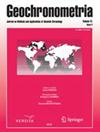波兰Złota黄土矿床的发光年代地层
IF 0.9
4区 地球科学
Q3 Earth and Planetary Sciences
引用次数: 17
摘要
波兰黄土地层与北半球更新世的变冷和变暖趋势密切相关。黄土层序敏感地记录了区域古气候和古生态的变化。Złota黄土剖面(21°39′e, 50°39′n)为重建波兰这一地区过去的气候条件提供了独特的机会。这种连续的黄土和古土壤沉积序列可以区分温暖和湿润的气候,这有利于土壤的发育,而寒冷和干燥的气候则有利于黄土的积累。粉质和砂质风成物质主要来自受霜击碎影响的风化岩石表面或河流冲积平原的冰川/河流沉积物。在波兰,黄土和类似黄土的地层出现在该国的南部,主要在波兰南部高地,即卢布林、桑多梅日和克拉科夫高地。我们使用了不同的技术来为这个网站建立一个时间框架。从Złota所研究的黄土剖面中采集了21个样品进行发光测年。多矿物细粒(4 ~ 11µm)采用ir后IRSL测年方法。测年结果伴随着对地球化学组成、有机碳和碳酸盐的详细分析。并对其磁化率和粒度分布进行了分析。基于如此庞大的地层数据集,利用OxCal建立了该遗址的年龄-深度模型。本文章由计算机程序翻译,如有差异,请以英文原文为准。
Luminescence chronostratigraphy for the loess deposits in Złota, Poland
Abstract Loess formations in Poland display a close relationship with cooling and warming trends of the Northern Hemisphere during the Pleistocene. Loess sequences sensitively record regional palaeoclimatic and palaeoecological changes. The Złota loess profile (21°39’E, 50°39’N) provides a unique opportunity to reconstruct climate conditions in the past in this part of Poland. This continuous sequence of loess and palaeosol deposits allows to distinguish between warmer and more humid climate which is favourable for soil development and much colder and dry periods which are conducive to loess accumulation. The silty and sandy aeolian material originates mainly from weathered rock surfaces affected by frost shattering or from glaciofluvial/fluvial deposits of river flood plains. In Poland, loess and loess-like formations occur in the southern part of the country, mostly in the south polish uplands, i.e. in the Lublin, Sandomierz, and Cracow Uplands. We used different techniques to establish a chronological framework for this site. 21 samples for luminescence dating were collected from the investigated loess profile in Złota. Infrared post-IR IRSL dating method was applied to the polymineral fine grains (4–11µm). The dating results are accompanied by detailed analyses of the geochemical composition, organic carbon and carbonate. Also, analysis of magnetic susceptibility and grain-size distribution were investigated. Based on such a large stratigraphic dataset an age-depth model using OxCal has also been constructed for this site.
求助全文
通过发布文献求助,成功后即可免费获取论文全文。
去求助
来源期刊

Geochronometria
地学-地球科学综合
CiteScore
2.20
自引率
0.00%
发文量
1
审稿时长
>12 weeks
期刊介绍:
Geochronometria is aimed at integrating scientists developing different methods of absolute chronology and using them in different fields of earth and other natural sciences and archaeology. The methods in use are e.g. radiocarbon, stable isotopes, isotopes of natural decay series, optically stimulated luminescence, thermoluminescence, EPR/ESR, dendrochronology, varve chronology. The journal publishes papers that are devoted to developing the dating methods as well as studies concentrating on their applications in geology, palaeoclimatology, palaeobiology, palaeohydrology, geocgraphy and archaeology etc.
 求助内容:
求助内容: 应助结果提醒方式:
应助结果提醒方式:


